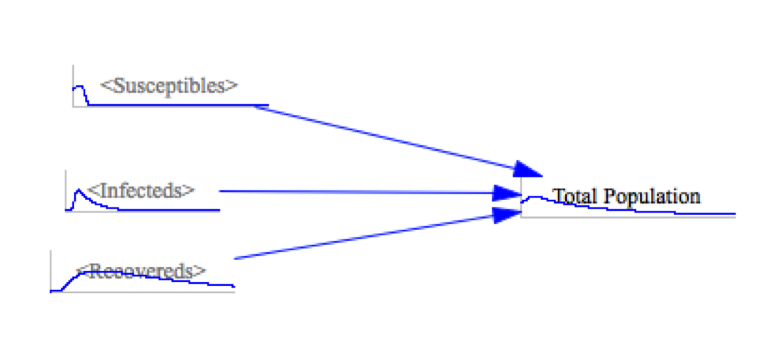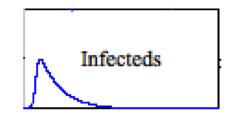Advanced SIR Learning Scenario (Web)
Learning Scenario - Advanced SIR (Vensim)Basic Model:DescriptionThis is a system model of the spread of the disease in a population. It tracks the proportion of the population that is infected by the disease on any given day. The infection probability, recovery rate, loss of immunity fraction, birth rate, and death rate are user-controlled parameters. A graph depicts the change in the number of people who are susceptible, infected and recovered over the progression of the sickness. Background InformationHealth organizations around the world are always working to gather and share information about potential epidemics, and to try to understand how diseases spread and how they could play out in individual communities, states, and countries across the globe. A vital part of these efforts involve the use of computational models that make quantitative predictions about how the disease will spread, based on measured data and scientific understanding of the biological and systematic processes involved. This model can be used to learn about these processes and how they interact to determine the severity of the disease outbreak. Science/MathThe fundamental principle behind this model is HAVE = HAD + CHANGE. The overall shift in the number of people in the different populations each time tick depends on the number of people susceptible to the disease, as well as the number of infected people who have not been quarantined or medicated and therefore can infect them. Each time tick, the following things happen:
Teaching StrategiesAn effective way of introducing this model is to ask students to brainstorm how sicknesses such as the common cold spread, for example through physical touch or bacteria put in the air by coughing and sneezing. Then have students use the Disease Model to explore an easy to use disease model. Ask the following questions:
Implementation:How to use the modelThis relatively in-depth model has a number of parameters that can be manipulated to produce different results:
All of the aforementioned parameters are manipulated by clicking and dragging their respective sliders. The maximum, minimum, and step values for each parameter are pre-set. Any changes made to the sliders take effect immediately with the exception of the initial values, which take effect the next time the simulation is run. To run the simulation, click the "Run a Simulation" button. The Susceptible, Infected, Recovered, and Total Population changes over time are displayed below the model: 
Smaller graphs of these populations over shorter time periods can be found in the box containing the variable. For example: 
For a complete tutorial on how to use Vensim, please go to the following link here. Learning Objectives
Objective 1To accomplish this objective, have students run the simulation with the default parameters, and observe the graphs. They should specifically pay attention to the rate at which the populations of healthy and sick people increase and decrease. Ask the following questions:
Objective 2Have students experiment with each of the parameters to see the effect on the graph. Ask the following questions to guide their exploration:
Extensions:
Extension 1Encourage the students to discuss the uses of disease models in preparing for epidemics. Ask the following questions:
Extension 2Have students consider the ways in which this model is not an accurate representation of the real world. Ask the following questions:
Related ModelsDisease Epidemic ModelThis is the agent model version of the Vensim Epidemic model created in NetLogo. It contains many of the same variables, as well as adding the option of barriers to represent traveling between regions or countries with strict travel laws. This model also contains a graph showing the number of people who are healthy, sick, immune, and dead. Students should discuss the pros and cons of this model as a way of predicting the spread of disease in comparison to the Vensim model. Supplemental Materials:
Spread of Disease ModelThis is a simpler agent model of disease spread that focuses on the longevity of the disease. This model is unique because the agents do not gain permanent immunity to the disease after they recover. Students should discuss the affect this has on the spread of disease and how this changes the methods used to prevent the disease. Diffusion in a Box ModelThis is a model of basic diffusion created using AgentSheets software. Students should discuss the ways in which disease spread in a population is an example of diffusion. 
|